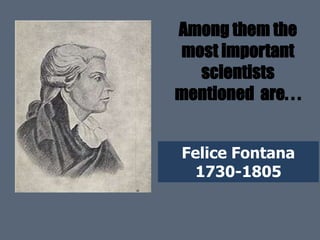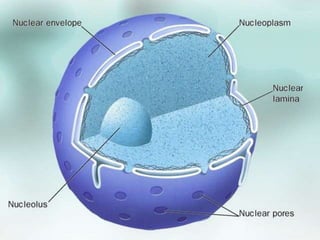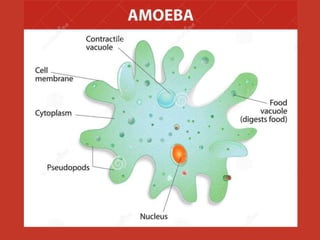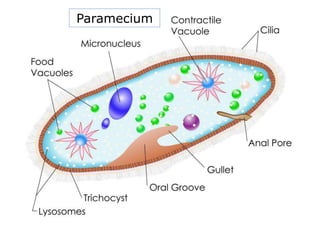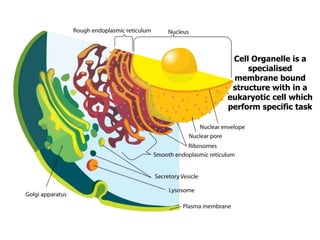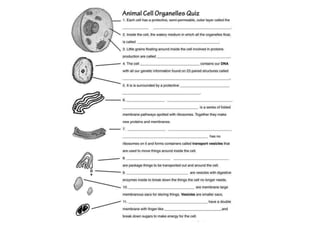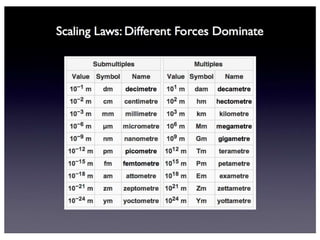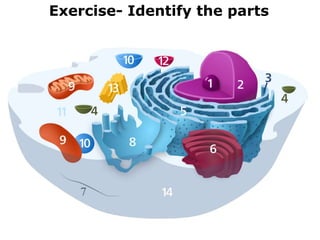Cell the basic unit of life
- 1. Cell: The unit of life.
- 2. Before the first microscope was invented around 360 years ago, People were not aware of living world that was not visible to the naked eye.
- 3. Many Scientists were observing and describing unknown world with the help of Microscopes
- 4. Among them the most important scientists mentioned are. . . Athanasius Kircher 1601-1680
- 5. Zacharias Janssen Among them the most important scientists mentioned are. . .
- 6. Among them the most important scientists mentioned are. . . Jan Swammerdam 1637-1680
- 7. Among them the most important scientists mentioned are. . . Anthony Van Leeuwenhoek 1632-1723
- 8. Among them the most important scientists mentioned are. . . Robert Hooke 1635-1702
- 9. Among them the most important scientists mentioned are. . . Robert Brown 1773-1858
- 10. Felice Fontana 1730-1805 Among them the most important scientists mentioned are. . .
- 11. Discovery of the cell Robert Hooke in the year 1665 observed thin slices of cork under a simple magnifying device he designed.
- 12. Discovery of the cell He observed that the cork resembled the structure of honey comb consisting many empty box like cavities - Cells.
- 13. A significant observation In 1831 Robert Brown noticed a near- circular spot slightly more opaque than the surrounding areas.
- 14. A significant observation Robert Brown claimed that this structure was an integral part of the cell and called nucleus.
- 15. The Modern Cell Theory consists of three statements based on large body of scientific research. The orginal work was done by Schleiden, Schwan and Virchow
- 16. 1. The cell is the fundamental unit of structure and function in living things. 2. All living things are composed of cells. 3. Cells come from pre existing cells.
- 17. Cell is a functional and Structural Unit of Life Each cell is a membrane bound body that contain all chemical molecules that help support organisms life.
- 18. Cell is composed of various parts. Cell is made up of 3 basic components 1. Plasma membrane 2. Nucleus 3. Cytoplasm.
- 19. Plasma membrane is the outer most covering of the cell separates it contents from external environment. Plasma membrane is semi permeable membrane and made up of fats and proteins.
- 20. Nucleus is the control centre of the cell and has a double layered covering called nuclear membrane Nucleus contains genetic material (Chromosomes) Which will have DNA
- 22. * Nucleus * Membrane bound organelle * Cytoskeleton * Complex * No Nucleus * No Membrane bound Organelle * No Cytoskeleton * Simple . Cytoplasm • DNA • Plasma Membrane Eukaryotic Cell Prokaryotic Cell
- 23. Cytoplasm is the fluid substance that fill the cell and contain various organelle for various functions.
- 24. There are cells without nucleus they are called Prokaryotic cells. They do have Nucleoid
- 25. Cells with prominent nucleus are called Eukaryotic cells.
- 26. 0.1 -10 micro metes 10 -100 micro metes
- 30. Paramecium
- 31. Vacuole Chloroplast Flagellum Cellulose wall Eye spot Starch storage Chlamydomonas
- 37. Cell Organelle is a specialised membrane bound structure with in a eukaryotic cell which perform specific task
- 39. Cell Organelle – Golgi apparatus
- 47. Diversity in Cells of a
- 54. Diversity in Cells size
- 55. Diversity in Cells size
- 56. Diversity in Cells size
- 57. Microscope
- 58. Microscope
- 60. Measure
- 63. Exercise- Identify the parts
- 64. Exercise- Identify the parts
- 65. Exercise- Identify the parts
- 66. Exercise- Identify the parts
- 68. Exercise- Identify the parts










